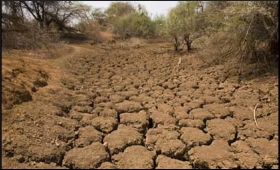|

|
Concern mounts as India sees 12 pc deficit monsoon
|
|

|
|
| Top Stories |
 |
|
|
|
SME Times News Bureau | 03 Jun, 2015
An official forecast of a 12-percent rain deficit during this monsoon season caused much concern in India over a possible crop failure, drought, inflation and an overall adverse impact on the economy, spooking a key stock index by nearly 2.5 percent and even prompting a key minister to invoke god.
"The latest forecast is bothering me. The rainfall this monsoon is likely to be below normal-to-deficient at 88 percent -- plus or minus four percent -- of the normal (average) rainfall, which is down from 93 percent in April," said Science and Technology Minister Harsh Vardhan.
"Let's pray to god that the forecast does not come true," he said on the margins of an event in Noida, adding that the likelihood of a shortfall of rain below the long-term average from 1951-2000 had now risen to 93 percent from 68 percent that was predicted in April.
Incidentally, when the minister was revealing the latest forecast, Reserve Bank of India Governor Raghuram Rajan was expressing concern over the deficient rains based on an earlier forecast of 7 percent shortfall. This added to the alarm.
"For the kharif season, the outlook is clouded by the first estimates of Indian Meteorological Department (IMD), predicting that the southwest monsoon will be 7 percent below the long period average," Rajan said.
The Kharif season starts in June with sowing when monsoon begins and its crop is harvested in November, while the rabi season begins with sowing in November and the crop, especially wheat, is harvested in April-May.
"What is clear is that contingency plans for food management, including storage of adequate quantity of seeds and fertilisers, crop insurance, credit and timely release of food stocks need to be in place to manage the impact of low output on inflation."
As the forecast on Tuesday came over and above an official statement last week of a likely four million tonnes of grain in the just-concluded fiscal year, and the central bank's assessment of a worsening of the situation, the concern was magnified.
The stock markets, accordingly, appeared to have ignored the rate cuts announced by the RBI and the key sensitive index (Sensex) of the Bombay Stock Exchange fell 660.61 points or 2.37 percent.
The importance of the annual weather phenomenon of monsoon can be gauged by the fact that it accounts for as much as 75 percent of India's rains and over half of the farm sector's water needs.
It is also singularly responsible for refilling the reservoirs, so crucial for the daily dose of water.
It even kept prevented the central bank from announcing a steeper cut in interest rates.
"Going forward, room may absolutely open up if monsoon is better than expected or government action can mitigate potential rise in food prices -- and if energy prices stay contained. Clearly, it is possible. More room may open up and we will take full advantage of," Rajan said.
Country's apex industry body Assocham too urged the government to "wake up" and take stock of the looming crisis.
"The government should wake up and make necessary preparations to deal with the situation. Co-ordination with all stakeholders is a must to save the farmers from agony," its secretary general D.S. Rawat said.
Nonetheless, the science and technology minister said Prime Minister Narendra Modi was monitoring the situation closely and has directed all ministries to make necessary preparations and take action to insulate citizens from hardship.
Harsh Vardhan said the northwest region, which includes Delhi, Haryana, western Uttar Pradesh and Rajasthan, would receive 85 percent of the average rain, with an error margin of 8 percent points, the minister added.
He said the probability of monsoon remaining below average -- rainfall between 96 and 104 percent of the long-term average (the average annual rainfall for the period 1951-2000) -- had risen from 68 percent in April to 93 percent now.
The minister blamed El Nino, a phenomenon that happens in the equatorial Pacific Ocean, as well as climate change due to global warming, as two of the many other reasons behind the forecast. "El Nino is definitely one of the reasons. So is climate change."
|
|
|
| |
|
|
|
|
|
|
|
|
|
|
|
|
|
|
| |
| Customs Exchange Rates |
| Currency |
Import |
Export |
US Dollar
|
66.20
|
64.50 |
UK Pound
|
87.50
|
84.65 |
Euro
|
78.25
|
75.65 |
| Japanese
Yen |
58.85 |
56.85 |
| As on 13 Aug, 2022 |
|
|
| Daily Poll |
 |
 |
| PM Modi's recent US visit to redefine India-US bilateral relations |
|
|
|
|
|
| Commented Stories |
 |
|
|
|
|
|
| |
|